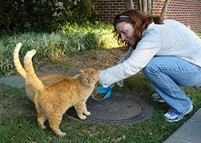*Correction: In a previous version of this story, the headline and content stated that the Feral Cat Program at SMU is facing budget cuts, when this is not the case. We regret the error.
By Nate Williams
A mysterious figure peers around a corner through glossy yellow eyes as bright as the stars above. The elusive feline prowls with intentional swiftness through the chilly November night. He startles at the click-clacking of approaching footsteps and scurries away revealing his jet-black fur glistening in the moonlight. His name is Tails and he is an SMU feral cat.
The population of feral cats at SMU is being cared for by a nearly invisible presence of students, faculty and community volunteers. These dedicated members of the Feral Cats Program at SMU feed and monitor the movements of these unique inhabitants.
“I don’t know that much about the organization, but I do know they fight hard at student government meetings to protect the cats,” junior Rachel Pomroy said.
Kim Pierce is one if the organization’s co-leaders. Her calling to the Feral Cat Program occurred 10 years ago when her own feral cat colony, a trio of orphaned cats, was on the verge of disappearing due to the demolition of her apartment complex to make room for the now George W. Bush Library.
She received a note addressed to “Good Samaritan” from the Feral Cat Program at SMU asking to merge her existing colony with another off campus colony to protect the magnificent cats.
“I was so grateful and astonished that I decided volunteering with the program was the least I could do in return,” Pierce said.
The Feral Cat Program at SMU prides itself on rescuing homeless cats and sometimes finding homes for felines found suitable for adoption. Members of the organization consider themselves the voices of SMU’s feral cats and advocate the importance of funding to keep the program alive.
“We hope to get a Summerlee Foundation grant to help with flea control,” Pierce said.
Donations, along with a budget of discretionary funds from President R. Gerald Turner, maintain the supplies of food and TNR (trap-neuter-release) programs for the feral cats. Without these vital sources of income, the organization would cease to exist and SMU’s cats would venture into new dangerous territories.
Unlike their domesticated counterparts, feral cats are considered wild because they have little to no human interactions or sufficient human handling. Although wild, many do not survive due to starvation, loss of habitat or extermination tactics used by humans who consider the cats a nuisance.
“They do get sick, they do get grabbed by coyotes and dogs or hit by cars,” said Veterinary Coordinator of Operation Kindness Derilyn Turner.
With over 15 years of veterinary experience, Derilyn Turner believes the disbanding of such organizations, like The Feral Cat Program, could mean the certain death of entire colonies.
“Rabies is a major concern or attacks on humans if they [the cats] are cornered,” said Cityvet of Oak Lawn Dr. Emily Redding.
Redding fears, without proper care, these harmless cats could pose potential health hazards to the people of SMU and the surrounding citizens.
“Awareness of the program is a double-edge sword for us. On the one hand, we like people to know that the cats are well cared for. One the other, there are people who don’t like the cats and do things like tip the feeding stations over and worse,” Pierce said.
For the members of this program it is much more than saving cats without homes, but instead about saving the lives of cats the SMU community has come to know and enjoy on a daily basis. They don’t ask for notoriety, but instead take satisfaction in saving the lives of these largely overlooked cats.
Tails emerges once again alerted by the succulent smell of tuna in the air. He arrives at Dedman Center and looks cautiously at his surrounding before indulging in the carefully prepared meal.
As Pierce and the other members of the Feral Cat Program sit down to enjoy their own meals, they are pleased to know that their silent, yet impactful cause has helped Tails and his fellow colony live to see another day at SMU.









